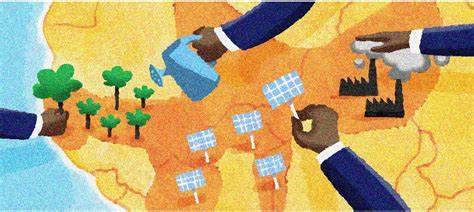Does Africa need a climate-centric financial architecture? Funmi Dele-Giwa, General Counsel & Head of GRC and Group Company Secretary at Onafriq presents his insights.

At the recently concluded COP28 climate summit in Dubai, African financial and political leaders spoke extensively about the role of finance in shaping Africa’s future, particularly regarding climate and the environment. Of particular note was the call by Wale Shonibare, Director for Energy, Financial Solutions, Policy and Regulation at the African Development Bank, for a new climate-centric financial architecture for the continent.
Speaking at an event on the sidelines of the summit, Shonibare presented what the bank calls a “moonshot” idea aimed at transforming Africa’s financial landscape. Among the proposals for this transformation is a bank of settlements and a new currency backed by commodity reserves, including oil.
“While the inclusion of oil might raise concerns in the context of climate change discussions,” he said, “it’s essential to understand that the proposal aims to leverage Africa’s commodity wealth to create a new financial architecture.”
But does Africa actually need a new, climate-centric financial architecture? Could it help ensure that the continent simultaneously meets its development goals and climate commitments? And if that is the case, how should it be implemented?
Frustration with the status quo
Many African leaders believe that a new financial architecture is needed because the rest of the world has not done enough to ensure Africa is in a position to build climate resilience while also developing. They’re especially aggrieved by the fact that, despite contributing just three percent of cumulative emissions and being among the regions most affected by climate change, the continent is being held to many of the same standards as more developed nations.
Legislation like the European Union’s Carbon Border Tax Adjustment Mechanism, for example, would significantly constrain Africa’s ability to export value-added products such as cement, iron, steel, aluminium and fertilisers to Europe. Given that Europe is Africa’s largest trade partner, that would be potentially devastating. Without the ability to export refined products, African countries would be forced back into exporting raw commodities, resulting in widespread de-industrialisation and job losses.
“Africa has been short-changed by climate change; now it will be short-changed in global trade,” said Dr Akinwumi A. Adesina, President of the African Development Bank Group in the run-up to COP28.
Turning inward for growth, climate resilience
As a result, some believe that Africa should turn inward for growth and development as well as climate resilience. As Adesina pointed out, the Africa Continental Free Trade Area (ACTFA), which could increase intra-African exports by over 81% by 2035, is an ideal springboard for this approach.
“The free trade zone should however be turned into an industrial manufacturing zone to generate maximum benefits and improve development and emergence of competitive industrial value chains for regional and global markets,” he said.
There is much to be said for this idea. Africa is, after all, one of a very few regions around the world where populations are still seeing significant growth. By 2050, the continent is expected to be home to 2.4 billion people. It’s also home to a young population, with 70% of Africans under the age of 30. Factor in growing levels of connectivity and education and you have the ingredients for the kind of innovation-led economic boom that will allow Africa to invest heavily in renewable energy and other forms of climate resilience.
If that boom is to last and be sustainable, intra-African trade and business will be essential. But free trade and industrialisation aren’t enough on their own.
Breaking down financial barriers
Any climate-centric financial architecture must also make it as easy as possible for money to flow between different African countries. Historically, this hasn’t always been easy.
In part, that’s because there is no central set of regulations governing cross-border payments in Africa. Instead, the organisations like Onafriq, who are facilitating these payments have to ensure that they’re compliant in every single market they cater to. That means that cross-border payments are often more complex and expensive than they need to be.
This doesn’t just make intra-African business payments more difficult and time-consuming, it can also add a layer of complexity to large-scale investments. Those kinds of investments will be crucial to Africa meeting its climate goals. It’s therefore imperative that any climate-centric African financial architecture include initiatives aimed at building a common set of payment regulations.
Another ongoing barrier to the free flow of money in Africa is exchange controls. Many countries across the continent have stringent controls aimed at preserving foreign currency reserves. As things stand, however, they can lead to significantly increased transaction costs for businesses involved in intra-African trade. That’s to say nothing of the increased bureaucratic hoops and administrative burden that they place on businesses.
Addressing exchange controls won’t only help alleviate those issues but will also help ensure that businesses rely less on the USD exchange rates when buying and selling within Africa. Here, the work done by the Pan-African Payment and Settlement System (PAPSS) is particularly important. The system enables instant, secure Pan-African payments and aims to simplify many of the historical costs and complexities associated with them.
Build a new architecture, but make it the right kind
There is no doubt that Africa has been seriously under-resourced when it comes to building climate resilience. The continent received just two percent of the US$3 trillion invested in renewable energy over the past two decades, for example. That means a new financial architecture of the kind envisioned by the AFDB may well be necessary.
If it’s to succeed, however, it cannot ignore how money flows within the continent. Indeed, ensuring that it’s as easy and safe as possible for money to circulate quickly should be seen as key to Africa meeting both its development and climate goals.
HedgeThink.com is the fund industry’s leading news, research and analysis source for individual and institutional accredited investors and professionals








